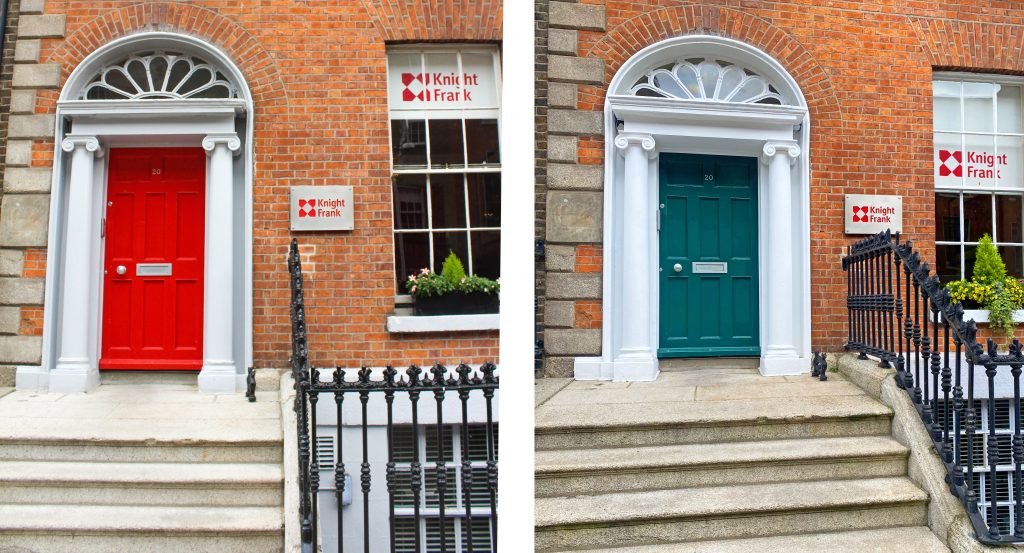
Georgian doors are a charming physical reminder of Dublin’s most interesting history. Dispersed through areas including Fitzwilliam Square, Merrion Square and St Stephen’s Green in the city centre, these cherished entrances are instantly recognisable by their diverse vibrant colours. In fact, you are unlikely to ever see two neighbouring doors painted the same colour! You’re also likely to recognise them by their stunning brass door knockers, notably the lion’s head and sphinx.
In this blog post we explore how the colours of these doors changed throughout the centuries and how they came to garner international recognition.
1700s and Early 1800s: Simplicity and Elegance
Dublin’s Georgian properties during this era were influenced by the neoclassical style. In alignment with this aesthetic, doors were often painted in soft shades like cream, beige, and light grey.
However there were exceptions, during this time a notable divide emerged between the aristocracy and the emerging middle class. Wanting to reinforce their social status, wealthier residents opted for more flamboyant door colours, such as bold reds and deep greens.

Mid to Late 1800s: Subdued Sophistication
The mid to late 19th century witnessed a transition towards a more restrained elegance in architecture. Dublin’s Georgian properties mirrored this shift by embracing darker, more sombre door colours. Navy blue, forest green, and rich burgundy became fashionable choices for door exteriors.
Early to Mid 1900s: Decline and Minimalism
The early 20th century brought challenges to Dublin’s architecture. Economic hardships, changing lifestyles, and shifting urban dynamics led to the neglect of many Georgian properties. As a result, the vibrant door colours gave way to utilitarian shades of grey, brown, and black.

Late 1900s to Today: A Colourful Revival

From the late 1900s, Dublin’s Georgian doors experienced a resurgence in colour. Efforts to preserve history led to a revival of vibrant door hues with cheerful shades of yellow, pink, and turquoise popping up around the city.
Tourists and photographers alike are drawn to these colourful facades, now iconic representations of Dublin’s unique charm. This trend has even influenced homeowners and businesses, inspiring them to embrace bold door colours and contribute to the city’s evolving narrative.
That famous postcard

Since the 1970s these doors have become an internationally recognised icon thanks to a New York-based advertising professional who, whilst visiting Dublin, decided to compile the colourful Georgian doors into a collage. The resulting picture, found in the Irish tourism office, swiftly evolved into a celebrated, award-winning poster. Today, souvenir shops offer postcards, calendars, prints and fridge magnets of these iconic doors.
An Old Legend

An intriguing narrative surrounding these vivid doors involves writers George Moore and Oliver St. John Gogarty, both of whom are believed to have profoundly influenced the works of James Joyce. Legend has it that Gogarty, returning home inebriated from the pub each evening, would mistakenly knock on his neighbour Moore’s door instead of his own. Frustrated by this, Moore painted his door green, hoping even a tipsy Gogarty could differentiate between the two. This trend gained traction, prompting other residents to adorn their doors in various colours, thereby granting their homes a unique identity.
The journey of Dublin’s Georgian door colours is a captivating tale that intertwines architectural styles, societal shifts, and cultural preservation efforts.
These doors serve as testament to the city’s evolution, reflecting the eras they have weathered.